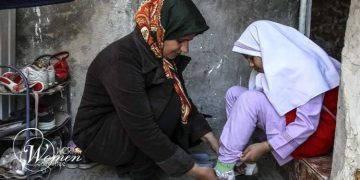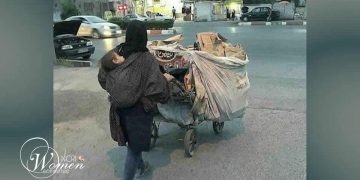Six million widows and counting
International Widows Day, June 23, is a United Nations ratified day of action to raise awareness of widows’ concerns and mobilize the support they require during trying times. The latest theme of the United Nations for this day is “Invisible Women, Invisible Problems.” But the problems of widows in Iran are far beyond being invisible.
More than 258 million widows worldwide are generally grappling with important issues of poverty, violence, and health. In Iran, the mullahs’ regime not only does not support widows but has turned their lives into hell by creating all kinds of legal, political, and social barriers.
Widows in Iran, especially if they are divorced, do not have the right to choose and determine their destiny in the family and society. Having a job, financial independence, social activities, and remarrying are associated with many challenges as they are treated as the “second sex.”
Growing numbers of widows in Iran
The Iranian regime offers contradictory statistics and is not transparent in providing the real numbers. However, all sources indicate a growing number of widows in Iran.
The National Statistics Center puts the number of divorced women or widows in Iran at 5.1 million. (The semi-official jahanesanat.ir – September 21, 2020)
The state-run Sharq daily had put the figure at 6 million on July 4, 2011.
Glancing through other state media reveals that in step with the growing trend of divorce, one out of every three marriages ends up in divorce. (The state-run radareghtesad.ir, February 18, 2022)
The divorce statistics in Iran have more than tripled over the past 15 years. The number of widows in Iran is 4 to 5 times greater than that of widowed men. (The National Statistics Center website amar.org and the state-run hamnava.ir, October 28, 2021)
Unemployment and poverty, the inevitable fate of widows in Iran
The clerical regime’s laws recognize women only in family roles, i.e., mother and wife. Women do not enjoy an independent identity before the law.
These laws violate many of women’s rights within the family. With the death of the husband, however, their problems multiply.
According to the laws of the clerical regime, if a man dies, the woman inherits only one-eighth of her husband’s property if she has a child. If the man has three or four wives, only this one-eighth is divided between them.
In this way, women who lack financial independence or savings are abandoned without any support. The problem is aggravated considering that the whole Iranian society suffers from unemployment and extreme poverty. Add to it the fact that men enjoy priority in employment.
Of the 71% of divorced women who live with their child or children, only 16% are employed. The rest need others to provide for their material needs. (The official IRNA News Agency – January 1, 2019)
Employers who work under no supervision in the corrupt clerical system take advantage of these needy women and hire them at wages much lower than their official minimum wage. These women, fearing the loss of their job, endure the slavery conditions at work and do not complain.

Deprived widows in Iran, abandoned as heads of households
The speaker of the mullahs’ parliament recently admitted that there are 5 million women heads of households in Iran.
Based on official statistics, 52% of these 5 million women heads of the household do not have insurance or receive pensions. More than one million, or 19%, do not have support coverage. (The state-run asriran.com – January 25, 2022)
“Many women, particularly those residing in villages or informal housings (i.e., slums) do not have financial security because they do not have a college education and living skills, or due to lack of suitable jobs,” said Zahra Ebrahimi, director-general of the office of women and family affairs in Sistan and Baluchestan.
She added, “The Covid-19 outbreak created more restrictions. These face further problems earning their living after social and economic relations changed due to the pandemic.”
At least 60% of women heads of households are over 50 years based on the data released by the Labor Ministry. However, border provinces in the east, including Sistan and Baluchestan, have the largest number of women heads of households under 18. (The state-run Hamshahrionline.ir – December 7, 2021)
How the patriarchal structure views widows in Iran
Under the mullahs’ rule, misconceptions and misogynistic judgments have made society insecure for widows in Iran to the point that they even feel embarrassed within the family.
Eighty-seven percent of these women say their security is little or none in the face of taunt and ridicule.
The behavior of widows in Iran is under the microscope, especially in a country where the law allows any man on the street to blame and warn women for what they wear.
Such a misogynistic structure compels families to impose more restrictions on their daughter’s movement and occupation after returning home from an unsuccessful married life. (The state-run IMNA.ir – April 14, 2022)
Their husbands’ family controls many women once he passes away. They lose their rights, including their freedoms, custody of children, and property management.
In some regions, tribal traditions force a widowed woman to marry her brother-in-law or other relatives of the late husband.
In the mullahs’ patriarchal culture, even the remarriage of a widow is very difficult, especially if she has a child. They view this as infidelity to the deceased spouse and forsaking her motherhood role. As a result, some widows are pushed into shaky temporary marriages and become the second wife of other men. (The state-run asriran.com – June 22, 2020)
In such conditions, women lose their confidence, eventually isolate themselves, and abandon social activities.
Women’s frustration feeds into the cycle of malnutrition, begging, addiction, homelessness, working children, and many other social ills.

Low age of marriage and the growing number of widowed children
The age of widows in Iran has reached 15 years. (The official IRNA News Agency – January 1, 2019)
The clerical regime’s misogynistic policies promote the early marriage of girls to advance their Population Growth Plan.
According to the mullahs’ civil code, the legal age of marriage for girls is 13. Girls can be forced to marry at a younger age at their father’s discretion or a judge. Iran has the lowest marriage age for girls after New Guinea.
31,379 girls between 10 and 14 were married in 2020. The number of girls married between 10 and 14 increased by 32% in 2021. (The state-run Jahanesanat.ir – March 8, 2022, and Eghtesadnews.ir – November 22, 2021)
Since children are not mentally and financially prepared at this age to run a married life, many of these marriages end up in divorce.
The National Statistics Center data shows that 192 girls between 10 and 14 and 3,590 girls between 15 and 19 years got divorced. They joined the population of widows in Iran in Autumn 2020. (The state-run Borna.news – July 25, 2021)
It is appropriate to recall that in June 2019, Massoumeh Agha Alishahi, a member of parliament, spoke about 24,000 child widows in Iran who were under 18 years of age.
In 2017, Shahrbanou Emami, a Tehran’s City Council member, revealed that there were around 15,000 child widows in Iran under the age of 15. (The state-run rokna.net – May 28, 2018; the state-run ILNA.ir, March 8, 2018)
And more effort to lower the age of marriage!
While widows have no rights in Iranian society, the regime’s parliament is concerned about falling marriage and childbearing rates. It believes that one of the main reasons for this phenomenon is the rising age of marriage.
“The strategy to resolve the marriage issue should consider the factors that contribute to raising the marriage age and the relation between those factors,” said a report by the Parliament’s Center for Research.
The report believes the solution is to lower the occupation and education level. It writes, “One of the essential and effective strategies in lowering the marriage age relies on a system of education and employment that does not rely on higher education. The age of marriage is lower in cities that have higher job creation. (The Research Center of the Parliament – June 6, 2022)
In addition, the mullahs’ parliament recently adopted the Population Growth Plan on Khamenei’s order. The plan has increased women’s problems considering the dire economic conditions, unemployment, and lack of housing.
























